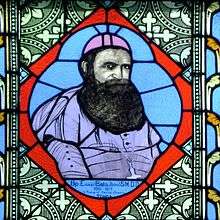Soakimi Gatafahefa
Soakimi Gatafahefa (1838 – 24 May 1896), also known as simply Soakimi Gata, a Polynesian transliteration of Joachim Gata, was the first Roman Catholic priest from Polynesia. A member of the Society of Mary (Marists), he worked in several Oceanic countries including Tonga, Samoa, Fiji, Wallis and Futuna, and later Australia and New Zealand.[1]
Biography

Gatafahefa was born on Lakeba in the Lau Islands, Fiji, the son of Tongan parents. From the island of Tongatapu, his family were relatives of Tāufaʻāhau, the later Tongan King George Tupou I. He converted to Roman Catholicism with his father. Baptized as Soakimi or Joachim, he spent most of his formative years on Futuna. He studied to be a priest and learned Latin at the Kolopelu School on Futuna, and at the Seminary of Lano, on Wallis, founded by French Marists missionary priest, Bishop Pierre Bataillon, the Vicar Apostolic of Central Oceania.[2][3][4]
Recognizing his potentials, Bishop Bataillon took Gatafahefa with him to Sydney, Australia for further education at a local seminary. In 1856, he took him to Europe along with two other Polynesian students: a Rotuman named Rafaele and a Wallisian named Motesito. They visited France and Rome, Italy where Gatafahefa met Pope Pius IX. Staying in Rome, the three students attended the Propaganda College and studied to become priests. He was the only one of the Polynesian students to finish his studies and was ordained to the priesthood by Cardinal Costantino Patrizi Naro on 10 June 1865 at the Archbasilica of St. John Lateran. Thus he became the the first Polynesian to be ordained a priest.[5] Despite his training in Europe, his later appointment in Tonga, Samoa and Wallis and Futuna was met with controversy.[2][6] Encyclopedic sources claim that Bishop Bataillon believed that Gatafahefa was attempting to persuade the people of Futuna to distance themselves from European Roman Catholic clergymen.[7]
After these incidents, Gatafahefa was sent for retraining in Sydney. He subsequently lived and worked for twenty years in New Zealand as a Marist lay preacher and taught at the Marist Seminary in Greenmeadows, where he was known as "Brother Joe."[7][3] He died on 24 May 1896, at the age of 58, and was buried in the Taradale Cemetery, Napier, Hawke's Bay; the name "Father Joachim Gata Gatafahefa" was inscribed on his gravestone.[8] After his death, although other Polynesians entered the priesthoods, no indigenous Tongans were ordained as Catholic clergymen until 1925.[9]
References
- ↑ Munro & Thornley 1996, p. 37
- 1 2 Lange 2006, pp. 110–111, 117, 119–120
- 1 2 Fiche 3P.16/17/18/19. L’environnement religieux en Océanie à l’époque coloniale: impacts sur les populations. Synthèse. p. 10.
- ↑ Kennedy; et al. The First Oceanian Marist: Petelo Likumoakaaka (PDF). pp. 166–168.
- ↑ Lange 2006, p. 110
- ↑ Revue du Monde Catholique 1867, p. 656
- 1 2 Lal & Fortune 2000, pp. 186–187
- ↑ Grave Marker of Father Joachim Gata Gatafahefa. Napier, New Zealand: Taradale Cemetery.
- ↑ Lange 2006, p. 112.
Bibliography
- Lal, Brij V.; Fortune, Kate (2000). The Pacific Islands: An Encyclopedia. Honolulu: University of Hawaii Press. ISBN 978-0-8248-2265-1.
- Lange, Raeburn (2006). Island Ministers: Indigenous Leadership in Nineteenth Century Pacific Islands Christianity (PDF). Christchurch, New Zealand: Macmillan Brown Centre for Pacific Studies, University of Canterbury. ISBN 978-1-74076-176-5.
- Munro, Doug; Thornley, Andrew, eds. (1996). The Covenant Makers: Islander Missionaries in the Pacific. Suva, Fiji: Pacific Theological College and The Institute of Pacific Studies at the University of the South Pacific. ISBN 978-982-02-0126-2.
- Revue du Monde Catholique. XVII. Paris: Librairie Victor Palmé. 1867.